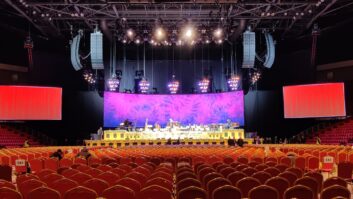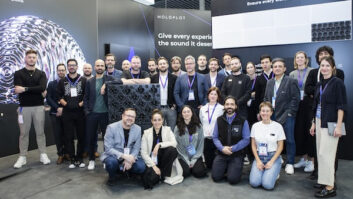
Previously, we looked at how AVB/TSN adherents believe that the protocol can improve on its trailing market position. Here, Ian McMurray looks at how its connections with the wider IT world might be a factor in this.
AVB adherents note how AVB plays into the increasing – like it or not – IT-ification of pro AV.
“Since AVB/TSN is an accepted set of IEEE standards, the IT world accepts it,” believes Shell Haffner, director of product management at Biamp Systems.
“As an IEEE standard, AVB was created at the core of the IT world,” adds John McMahon, vice president of solutions and strategy at Meyer Sound. “Because it’s universally recognised as an IEEE-defined protocol, the IT people can be confident that it will work as intended on their converged networks.”
“Gone are the days,” he laughs, “when CobraNet would appear on a corporate network, and the IT department wouldn’t recognise it – and so shut it down.”
One of the most-touted advantages of AVB has long been that it is not just about audio – its specification includes video, with Patrick Prothe, Avnu Alliance pro AV segment chair, believing that the emergence of networked video makes the transition to AVB inevitable. However: video implementations have thus far been somewhat few and far between. Biamp, though, is very much a believer.
“Video is a larger and more complicated data stream – think lip sync,” notes Haffner, “and this difficulty increases as systems become more complex in size, distance, and the type of data the network is transporting. For Biamp, we knew we would do video long before we moved to making AVB/TSN our protocol of choice. When AVB/TSN provided the capabilities we required to deliver low latency, time sensitivity and scalability, we made sure that both audio and video were capable within the same Tesira platform.”
Great experience
“From a Biamp perspective,” he goes on, “we view AVB/TSN as a transport mechanism to deliver a great experience to our customer base – whether that experience is only audio or includes video streams.”
“It might take years to fully realise the advantage of Avnu-certified networks and there will be short-term wins for companies on either side,” believes Prothe, “but in the end, the only long-term solution is technology that is based on true open standards and backed by the very companies whose job it is to support the development of the IoT network – the IT companies such as Cisco, Intel and the like.”
“We’re seeing many more infrastructure vendors working on Avnu-certified AVB switches and expect additional announcements this year,” he goes on, noting that 95% of switch silicon vendors are members of the Avnu Alliance. “We expect the certified ecosystem to continue to see momentum and the rate of growth to increase.”
It’s not just about the principles that AVB represents, however. For it to succeed for manufacturers such as Biamp and Meyer Sound – and others – it also has to deliver real, tangible benefits. They believe it does.
“AVB provides the quality that our customers demand, both sonically and in terms of reliability,” says McMahon. “Adoption will continue to expand as more switches come online, and as the technology ecosystem continues to grow both in the pro AV industry and in wider markets.”
Pivotal
“AVB has a very bright future – in 4K with perfect lip sync,” says Haffner. “We believe AVB/TSN will continue to be adopted within the industry. This will happen alongside other industries, which in turn will increase the interoperability across systems. AVB/TSN will be pivotal as the Internet of Things continues to expand and become more commonplace.”
Their optimism seems entirely justified, not least because the IT departments that are becoming increasingly influential in the AV world tend to be significantly more comfortable with open standards – especially those that are specifically designed for the networks of today. It is pretty much the definition of an industry standard rather than a de facto standard, putting it very much in line with the interoperability and open architectures that are only increasing in importance. The fact that it is, apparently, unique in its ability to handle multiple traffic types is unquestionably a potentially huge advantage.
Beyond this, the wider-scale adoption that TSN promises will, inevitably, see economies of scale apply – and prices will fall. It’s a technology with the Internet of Things at its heart – which can only be extremely helpful to its cause. Add the backing of numerous networking industry heavyweights, and it’s hard to see anything other than a positive future for AVB. AVB has substantial ground to make up – but if its time hasn’t quite come yet, it surely can’t be far off.







